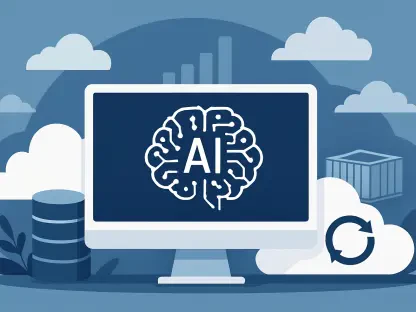The rapid advancement of artificial intelligence (AI) has brought to light a significant misalignment between public cloud infrastructures and the unique demands of AI workloads. Despite substantial investments by leading cloud providers like Microsoft, the architectural inadequacies of their offerings for AI applications are becoming increasingly apparent. Because of this, enterprises are grappling with performance bottlenecks and soaring costs, raising questions about the sustainability of using public clouds for AI tasks.
The Disconnect Between Public Clouds and AI Workloads
Generalized Infrastructure vs. Specialized AI Needs
Public clouds were initially designed to support generalized computing tasks, which include standard enterprise applications. However, AI workloads demand much more from their infrastructures, including high-performance hardware configurations, large data throughput, and intricate orchestration capabilities. This fundamental mismatch has resulted in skyrocketing and often unpredictable costs, alongside performance bottlenecks and infrastructural limitations that make it challenging for AI to achieve sustained growth. Enterprises leveraging public clouds for AI have found these platforms lacking, catalyzing the need for more specialized solutions.
The need for specialized infrastructure becomes glaring when AI tasks like training sophisticated models and managing large datasets come into play. These operations require a computing environment capable of handling sustained, intensive computational processes. The generalized nature of public clouds, which efficiently cater to ordinary web applications and databases, often falls short. As a result, performance issues arise, hampering the efficiency and scalability of AI initiatives. Such mismatches underscore the importance of evolving public cloud offerings to align with AI’s unique needs.
Financial Strain on Enterprises
Enterprises attempting to scale their AI initiatives are encountering unexpectedly high costs, a concern that continues to grow. Intensive AI operations, such as training complex models or managing vast datasets, become prohibitively expensive under current public cloud pricing models. Although these pricing models work well for traditional applications, they do not translate into proportional business value for AI tasks. Consequently, enterprises face excessive cloud bills, sparking widespread concern and prompting many to reconsider the viability of public cloud infrastructures for AI.
Unexpected costs associated with running AI workloads on public clouds stem from various factors. Firstly, AI operations often require substantial computational resources, which are billed at premium rates by public cloud providers. Secondly, the unpredictable nature of AI tasks and their resource requirements lead to fluctuating expenses, making it difficult for enterprises to forecast their cloud spending accurately. This financial strain may impede AI advancement, as companies allocate more funds to cloud expenses rather than innovative AI development. Enterprises must explore alternative strategies to mitigate these costs and sustain their AI growth.
Technical Limitations of Public Clouds
Inadequate Computational Resources
The generalized infrastructure of public clouds falls short when it comes to meeting the sustained, intensive computational needs of AI. What suffices for ordinary web applications or databases is often inadequate for modern AI workloads, which require robust and specialized computing environments. This inadequacy prompts enterprises to explore alternatives such as private AI infrastructure, hybrid solutions, and AI-focused microclouds. These options offer more predictable performance and cost-effectiveness, addressing some of the core limitations associated with public clouds.
Private AI infrastructure and hybrid solutions provide dedicated resources tailored to the demands of AI workloads. These infrastructures are designed to handle intensive computational tasks, thus delivering the performance required for training and deployment of sophisticated AI models. Moreover, AI-focused microclouds, which offer flexibility and control, have emerged as attractive alternatives. These microclouds provide specialized support for AI workloads, ensuring consistent performance and cost predictability. By moving away from public clouds, enterprises can better align their infrastructure with the specialized needs of AI.
Evolution in Business Models
Public cloud providers must adapt their infrastructure, pricing strategies, and service delivery methods to address the complex demands of AI. Traditional models of charging for general compute resources and imposing premium fees for AI-specific services are becoming increasingly unsustainable. Enterprises are now favoring platforms that offer more predictable costs and specialized support for AI workloads. This shift underscores the need for cloud providers to evolve their business models and services to remain competitive in the AI landscape.
The evolution of business models involves not only adapting pricing strategies but also developing services specifically designed to support AI workloads. For example, cloud providers can offer tiered pricing based on the intensity and duration of AI tasks, providing more cost-effective options for enterprises. Additionally, integrating specialized AI accelerators and optimizing infrastructure for high-performance computing will better serve the needs of AI. As enterprises continue to invest heavily in AI, they will seek cloud providers that can offer tailored solutions, driving a significant transformation in the public cloud industry.
Emerging Alternatives to Public Clouds
Private AI Clouds and On-Premises Hardware
Enterprises investing in AI are beginning to favor private AI clouds and traditional on-premises hardware. These options promise to remove the inefficiencies and unpredictable costs associated with general public cloud infrastructures. Companies prioritizing sustained and scalable AI initiatives are attracted to these emerging solutions, as they can offer the necessary computational power and reliability without the financial and performance constraints seen with public cloud services.
Private AI clouds and on-premises hardware provide several advantages in supporting AI workloads. They ensure dedicated resources exclusively available for AI tasks, thereby eliminating competition with other applications for computational power. This exclusivity enhances performance reliability and consistency. Furthermore, owning and managing hardware allows for customization and optimization tailored to specific AI needs. This control over infrastructure leads to greater predictability in performance and cost, making these alternatives appealing to enterprises committed to advancing their AI capabilities.
AI-Focused Microclouds
New AI-focused microclouds, such as CoreWeave, are gaining traction for their ability to offer a blend of flexibility and control. These platforms serve as an attractive alternative to public clouds, providing specialized support for AI workloads. By ensuring more predictable performance and cost-effectiveness, AI-focused microclouds address many of the limitations inherent in traditional public cloud infrastructures. As enterprises seek to streamline their AI operations, these microclouds represent a promising shift toward more adaptable and efficient solutions.
AI-focused microclouds are designed to handle the specific demands of AI operations, enabling enterprises to execute intensive workloads without compromising on performance. These microclouds offer scalability akin to public clouds, but with a focus on providing the necessary resources tailored to AI. This specialization helps mitigate many issues related to cost unpredictability and performance bottlenecks. Additionally, the flexibility offered by AI-focused microclouds allows enterprises to scale their AI efforts efficiently, ensuring that they can adapt to evolving technological advancements and market demands without significant challenges.
Strategic Approaches for Enterprises
Hybrid Strategy
A hybrid strategy leverages the agility and scalability of public cloud resources for experimental phases while dedicating specialized private infrastructure for intensive AI workloads. This balanced approach enables organizations to achieve flexibility and efficiency, crucial for dynamic AI experiments and production-level AI systems. By integrating both public and private resources, enterprises can optimize their AI operations to address varying demands effectively and sustainably.
Implementing a hybrid strategy involves careful planning and assessment of AI workload requirements. During the experimental phases, the scalability and cost-effectiveness of public clouds are advantageous. However, for resource-intensive stages such as model training and large-scale data processing, private infrastructure provides the necessary computational power and cost predictability. This dual approach ensures that enterprises can explore innovative AI solutions without facing prohibitive costs or performance degradation. A hybrid strategy also allows for smoother transitions between different stages of AI development, fostering continuous improvement and scalability.
Effective Cost Management
Effective cost management is essential for enterprises investing in AI. Finance teams are advised to use sophisticated tools that provide real-time tracking of cloud usage, helping to analyze the total cost of ownership and uncover valuable insights about reserved instances and committed-use discounts. By thoroughly understanding these cost elements, businesses can select the most economical options for their predictable AI workloads, ensuring financial sustainability and maximizing the return on their AI investments.
To achieve effective cost management, enterprises can adopt practices such as implementing budgeting and forecasting tools that track and predict cloud expenses. Monitoring cloud usage in real-time helps identify inefficiencies and opportunities for cost-saving measures. Additionally, negotiating discounts with cloud providers and committing to long-term use agreements can significantly reduce costs. Enterprises should also consider leveraging automation tools that optimize resource allocation based on workload demands. Through these strategies, businesses can better manage their cloud expenses and enhance their financial stability while pursuing AI innovations.
Detailed Assessment of Infrastructure Requirements
Enterprises must undertake a detailed assessment of their infrastructure requirements to make informed decisions about their AI environments. Determining which workloads genuinely need cloud scalability and which can efficiently run on dedicated hardware is essential. Investing in specialized AI accelerators ensures a balance between cost-efficiency and optimized performance, preventing overspending while maintaining high computational efficacy. A comprehensive understanding of infrastructure needs enables enterprises to align their resources with their AI goals effectively.
Conducting a thorough assessment involves evaluating the specific demands of various AI workloads. Some tasks, such as real-time data processing and inferencing, may benefit from cloud scalability, whereas others, like deep learning model training, require substantial computational power best provided by dedicated hardware. Enterprises should also consider the long-term sustainability of their AI infrastructure investments, ensuring that chosen solutions can adapt to future advancements and scalability needs. By aligning infrastructure strategies with AI aspirations, businesses can achieve efficient and impactful AI deployments.
Risk Mitigation Strategies
Avoiding vendor lock-in is crucial for enterprises to maintain flexibility in their AI operations. Ensuring that applications are portable and mastering container orchestration are pivotal strategies. Maintaining a flexible data architecture allows enterprises to pivot smoothly as necessary, adapting to new technologies or platforms without being tied down to a single provider. These risk mitigation strategies ensure that companies can navigate the evolving AI landscape with agility and resilience.
To mitigate risks effectively, enterprises should prioritize building applications using open standards and technologies that enable seamless portability across different cloud environments. Containerization and container orchestration tools, such as Kubernetes, facilitate this portability, ensuring that applications can be easily moved and scaled as needed. Furthermore, adopting a modular data architecture supports integration with various platforms and technologies. By implementing these strategies, enterprises can minimize dependencies on specific providers, reducing the risk of vendor lock-in and enhancing their ability to embrace new innovations and opportunities in AI.
Conclusion
The rapid progress in artificial intelligence (AI) has highlighted a notable mismatch between public cloud infrastructures and the specific requirements of AI workloads. Although major cloud providers like Microsoft have made significant investments, the shortcomings of their architectures for supporting AI applications are increasingly evident. Companies now face performance issues and rising costs, prompting concerns about the long-term viability of public clouds for AI tasks. These challenges stem from the fact that traditional cloud infrastructures, designed for general computational needs, struggle to keep up with the high demands of AI operations. AI requires more specialized compute power, storage, and bandwidth, which generic public clouds are not optimized for. This mismatch not only hampers efficiency but also drives up operational costs. Enterprises must therefore navigate these challenges carefully, weighing the trade-offs of cost and performance in public cloud environments versus potential on-premises or hybrid solutions that may better cater to the unique demands of AI workloads.









